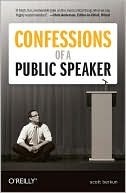More on this book
Community
Kindle Notes & Highlights
being stuck next to a person who will not stop talking for nine hours is my idea of hell.
Being naked or imagining naked people in the daytime makes most things more complicated, not less, which is one of the reasons we invented clothes. Despite it being very bad advice, it’s somehow the one universally known tip for public speaking.
If some disaster happens, something explodes or I trip and fall, I’ll have more attention from the audience than I probably had 30 seconds before.
If you’d like to be good at something, the first thing to go out the window is the notion of perfection. Every time I get up to the front of the room, I know I will make mistakes. And this is OK. If you examine how we talk to one another every day, including people giving presentations, you’ll find that even the best speakers make tons of mistakes.
never plan to use the full time given.
The next time you’re at the front of the room to give a presentation, you should know that, by all logic, you are the safest person there. The problem is that our brains are wired to believe the opposite;
Mark Twain, who made most of his income from speaking, not writing, said, “There are two types of speakers: those that are nervous and those that are liars.”
If you pretend to have no fears of public speaking, you deny yourself the natural energy your body is giving you.
Confidence, not perfection, is the goal.
Since I’m more afraid of giving a horrible presentation than I am of practicing for a few hours, practice wins. The energy from my fear of failing and looking stupid in front of a crowd fuels me to work harder to prevent that from happening. It’s that simple.
It’s common to see good speakers who don’t have much to say, as well as experts who are brilliant but boring.
It’s safe to assume that no matter where you stand, someone would be happy to be in your shoes, just as you’d be happy to be in someone else’s.
Place matters to a speaker because it matters to the audience.
If you’re in the audience, the angle of your body and the amount of eye contact you make with the speaker might not seem to affect your quality of experience, but for the speaker, it does. When 50, 100, or 5,000 people can give 10% more of their attention and energy to you — whether through their eye contact, posture, or laughter — it makes the difference between feeling confident and feeling lost. One extra pair of friendly eyes, or the visibility of an affirmative nod now and then, changes how any speaker feels.
My body chose to panic. Having panicked before, I knew the only trick was to start, as fear comes from what you imagine might happen instead of what actually is happening, and the longer you wait, the worse it gets. The only way to kill this evil feedback loop is to just do it, so I forced myself to begin.
I realized that the crowd size is irrelevant — what matters is having a dense crowd. If ever you face a sparsely populated audience, do whatever you have to do to get them to move together.
Make the room your own by asking the attendees to gather into that more intimate space.
If you pack them together, at least they’ll know they’re not the only losers who decided to come hear you.
It doesn’t matter where you are or how scared the crowd suspects you might be, if you have the mike and explain the situation with a smile, when you ask them nicely to stand up and move forward, they will.
The size of the room or the crowd becomes irrelevant as long as the people there are together in a tight pack, experiencing and sharing the same thing at the same time.
People with the courage to speak the truth into a microphone are exceptionally rare.
All good public speaking is based on good private thinking.
If you do not know the intelligent counterarguments to each of your points, your points cannot be good.


